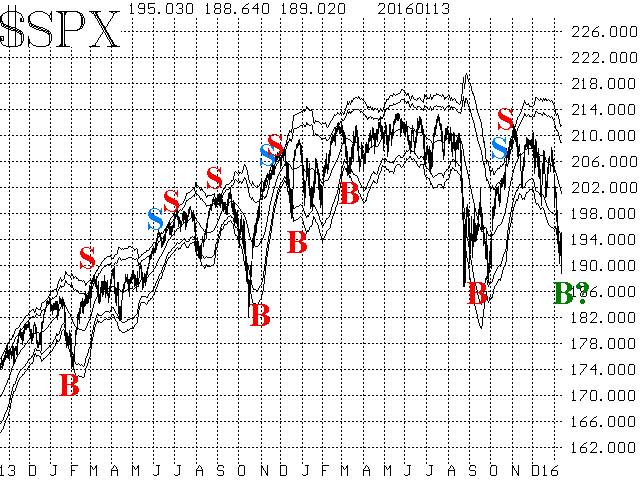
By Lawrence G. McMillan
A “modified Bollinger Band” (mBB) buy signal is nearly upon us. It almost occurred today (Thursday, January 13th), but missed by a couple of points. We began to wonder how past sharp market declines lined up with the eventual mBB buy signal. Was the first signal successful, or did it take a number of probes before the market eventually bottomed. Was the mBB buy signal the bottom of the market, or did it continue on downward at a later time? Those are good questions, and we’ll attempt to shed some light on them in this article.
This arcticle was orignally published on 1/15/16 as part of The Option Strategist Newsletter. Receive the articles when they are first published, along with specific trading recommendaitons by subscribing today.
The “mBB” System
For those now familiar with the mBB System – or for those who have forgotten – let’s review the particulars of the system. We use “modified Bollinger Bands” in order to create these signals. A mBB differs from the normal Bollinger Band (as invented by John Bollinger, and as found in many charting services) in the way that volatility is calculated. John Bollinger initially used the standard deviation of the closing prices of the undelrying over the past 20 days in order to calculate volatility. That seems like a logical thing to do, but in the Black-Scholes Model and in many other mathematical approaches to volatility, mathematicians have traditionally defined volatility as the standard deviation of daily closing price changes. So that’s what we use, because it is important that our volatilities line up with Black-Scholes implied volatilities in all of our analyses.
We draw four Bands around the chart of $SPX. The first set of Bands is spaced +/- 3 standard deviations (sigmas – σ) from the 20-day moving average of $SPX. And the second set is spaced +/-4σ. During periods of high volatility, the Bands are quite wide, and during periods of low volatility, they are quite narrow.
The actual system works like this. We first wait for $SPX to close outside of the +/-4σ Band. That creates an extremely oversold condition if it’s below –4σ Band or an extremely overbought condition if it’s above the +4σ Band. It is not easy for $SPX to move that far from its 20-day moving average, so this is a rather rare occurrence.
This condition has only occurred on 286 trading days since March 3rd, 1990 (286 out of the last 6,495 trading days, or 4.4% of the time).
Once $SPX closes outside the +/-4σ Band, we then wait for it to eventually close inside of the +/-3σ Band. That gives a buy signal at the lower Bands or a sell signal at the upper Bands.
We do not have a fixed rule for exiting the trade. We had done numerous studies and the best approach seems to be to use a trailing stop once the signal is in place. But the best exit is if $SPX moves all the way through to the opposite Band (from –4σ to +4σ, for example). Then one can exit on the opposite signal.

Figure 5 shows all of the mBB signals over the past two years. The red letters indicate successful signals – either from exiting at the opposite Band or from a substantial move that allowed one to exit with a trailing stop. The light blue letters generally show losing trades. In Figure 5, all of the losing trades were sell signals, and all were followed quickly by successful sell signals.
The History of Signals in Sharply-Declining Markets
Going back to the beginning of 1990, we have seen only a few severe market declines. Bear in mind that we are looking for cases where the market drops sharply, not just steadily grinds away. The following list is a brief summary of the signals that occurred at such times. In each of these cases, there was a cluster of days in which $SPX closed below the –4σ Band, before the mBB buy signal occurred.
- August 1990: third signal, sharply below first signal.
- August 1998: second signal, sharply below first signal.
- Feb 2001: second signal, sharply below first signal.
- Sept 2001: first signal was quite successful.
- June-July 2002: fourth signal, sharply below first signal.
- May 2006: first signal, but market went modestly lower before turning higher.
- July 2007: first signal, but market had one sharp probe lower before turning higher.
- Jan 2008: first signal, although retested the lows two months later.
- July 2008: second signal. Rally was modest.
- Oct 2008 – volatility spiked so sharply that the Bands widened out, and $SPX only closed below –4σ Band for four consecutive days (Oct 7th through the 10th). First signal was the only one, but it wasn’t very successful.
- March 2009: first signal was hugely successful.
- May 2010: second signal, sharply below first signal. Later signals in July and August were better.
- August 2011: first signal, but never produced much profit until after lows were retested nearly 2 months later.
- May 2012: second signal, not much below the first.
- Oct 2014: first signal was very successful.
- Aug 2015: first signal, but never produced much profit until after lows were retested a month later.
- Jan 2016: ???
There are quite a few of those bottoms where the first mBB buy signal was the only one that occurred. In essence, those are “V” bottoms of sorts. The most extraordinary of those were Sept 2001, March 2009, and Oct 2014. So one cannot ignore the first signal, as can be done with some other systems.
In many of the failure situations, the mBB buy signal produced a rally that only made it back to the declining 20-day moving average, and then collapsed further. This is the classic behavior of an oversold rally: it is only strong enough to relieve the oversold conditions, and that usually occurs at about the time that $SPX has risen just above its declining 20-day moving average. The one in August 2015 (just a few months ago) was typical of this behavior. It is impossible to tell which type of mBB buy signal it’s going to be when the first one occurs.
The Current Pending Signal
So this brings us to the present. If Figure 5, there is a green buy signal with a question mark. That refers to the present situation, which has not produced the first mBB buy signal in the current sequence. $SPX has closed below the –4σ Band on three of the last five days – on January 8th, 11th, and 13th. On the other two days, it rallied but was not able to close above the –3σ Band to generate the buy signal. At the current time (as of the close of trading on Thursday, January 14th), the –3σ Band was at 1928.60 and falling. The movements of the –3σBand are not all that predictable in advance, because it depends on two variables: 1) the location of the 20-day moving average, and 2) volatility.
Coming into Friday, only a modest rally is needed to generate a buy signal: $SPX only needs to rise above 1925.80 (it closed at 1921.84). However, from overnight trading in the S&P futures it looks like $SPX might be sharply lower today. Since this is a weekly publication, we are forced to make an estimate of where the buy signal might occur.
Another problem that arises, is that SPY call options are very expensive after a sharp market drop. Hence, buying them as the vehicle to trade the mBB buy signal (or any other oversold condition’s buy signal) can be somewhat self-defeating, because as the market rallies, implied volatility decreases. That decrease in implied volatility hurts the value of the calls you own. It’s sort of like a salmon swimming upstream; it can be done, but it’s not easy. The best way to counter this action is to buy something with no time value (SPY, or the S&P futures, for example, but that could be expensive in terms of capital required to establish the position), or to sell something with time value (sell a SPY put, but that has considerable risk if the market later collapses).
A sort of middle ground would be to use a $VIX calendar spread. This gives one leverage (for the margin requirement is relatively small) and does have a time value component. If one is looking to make money on a market rally using a $VIX calendar spread, he would sell the first month and buy the second month. For example, buy $VIX March futures and sell $VIX February futures, at this time. But be careful! This spread has very large risk if the stock market collapses. In 2008, a spread such as this widened from 1 point to 18 points. At $1,000 per point (which is the trading unit of $VIX futures), that was a huge loss, compared to the $625 margin required to establish the position at the time. Today, more margin is required (about $2,500), but the risk is the same. So one has to have a stop in mind if the calendar spread is used to trade the bullish mBB signal.
This arcticle was orignally published on 1/15/16 as part of The Option Strategist Newsletter. Receive the articles when they are first published, along with specific trading recommendaitons by subscribing today!
© 2023 The Option Strategist | McMillan Analysis Corporation

